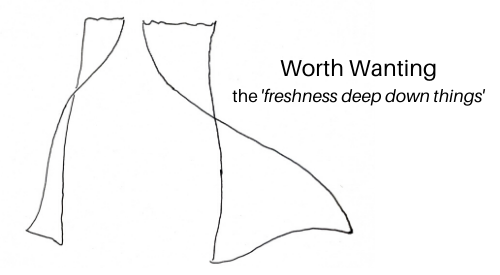
Part of the challenge of stay-at-home has been the absence of others, at least the kinds of others most obvious to me–strangers met face to face. No rides on crowded trains, no restaurant hubbub, no concert hall bustle during intermission, none of the ways we (okay, I) get a sense of the range of human variety, and maybe even find people to interact with and others to encounter.
Instead there’s my porch, the view from the picture window, the solitary walk in the park. Zoom meetings? But there’s an airlessness to them. Sometimes I feel we are ghosts conversing between our individual mausoleums.
What are chances of encounter in this situation? As much as I crave freshness, aren’t there just fewer opportunities for encounters these days?
Once I start totting up my resources of others/othernesses though, what I find is that the menu is different these days but no less full. In this and subsequent posts, I’ll explore the range of other/otherness options for the housebound.
Let’s make clear what makes someone or something not just different or a variety but other. First of all, an other has a concrete presence and a context. Second, an other is able to insist or resist for its own reasons, in its own way. Finally, an other has an inherent dignity despite, or perhaps because of, the fact of its fragility. Every other has a claim to existence as good as my own, and my existence is just as fragile.
By this standard, the young men who ride up and down my street on loud motorbikes are others, but not more other than the webhost I am using to publish this blog. And the foxglove blooming at the back of my garden is as other as the Covid 19 virus that may be near or far from me. (I wish I knew.)
Under this umbrella of otherness, there is room for many things: my wife (very familiar, very other), my neighbors across the street (we wave porch to porch), people in other states (oh, Arizona!), the book I’m reading to my grandkids (Duck for President), my unsteady feet (do what I tell you!), my city gradually coming out of lockdown (easy does it).
Some of these others I do or can or could meet directly. Other others I encounter indirectly. The author of a book can be a concrete presence. I can report, for instance, feeling the mind of one writer caressing mine almost palpably as I follow her description of a post-war English farming/mining village. Every word she chooses, every word picture she draws, is a concretization of her presence.
There’s another kind of other which has a very concrete but diffuse presence. Boston, for instance, or Forest Hills Cemetery where I like walk. This kind of other I call a plenitude–a whole to be known much larger than the part I already know.
So, these days, there are direct, indirect and diffuse others in my life, all of which we might call outer others, being external to me. However, there are inner others as well. These are things going on inside us that seem to come unbidden and a life of their own, no matter what our executive self says.
So, aspects of my heritage, such as first eight years of my life I live in London, for instance, are inner others for me to encounter. Then there are personal habits of behavior or belief such as convenient routines that resist all efforts to change. What about the role models I aspire to emulate? I don’t change my ideals to better describe me, rather I change myself to better conform to them. The vision of a world worth wanting may be an other I encounter. Sometimes I try to think something through, a puzzle, for instance, or the idea of encountering itself, which I will either resolve or not. When I’m trying to sketch something, I feel like I’m bringing out of my private self something concrete that will be ultimately be independent and public. These are inner others. I wrangle with them all the time to satisfy needs, to get things done, to feel at peace, to be what I want to be.
Then I, and everyone, has an inner plenitude that regularly manages to surprise, delight and appall us. This too can be an other to encounter.
For a full list of types of others and othernesses, click here.
So, even though many of the normal categories of others and othernesses are less well populated these days, there are still plenty of other kinds of others left to keep me busy encountering.
